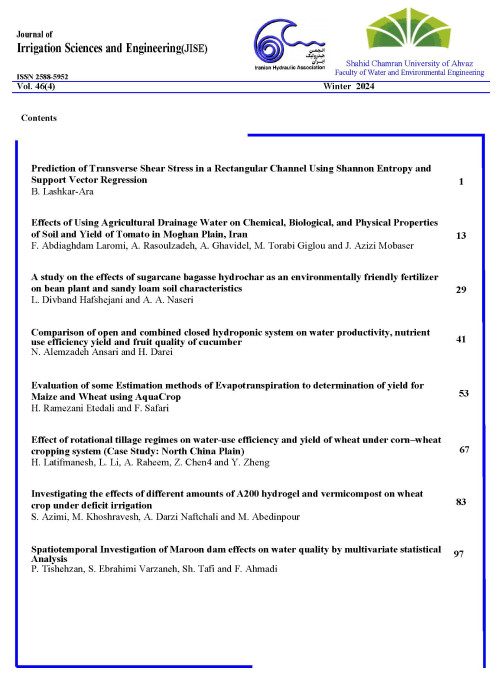Comprison of Fuzzy Possibilistic Regression and Fuzzy Least Square Regression Models to Estimate Groundwater Level of Neyshabour Aquifer
Groundwater has always been considered as one of the main sources of drinking, agriculture, and industrial water, especially in arid and semi-arid regions. Investigating groundwater level changes in any region has an important role in planning sustainable water resources management. Continuous decline of groundwater level has been observed worldwide in the past half-century. Groundwater is the most important and the only source of freshwater in Neyshabour plain. Unallowable discharges of the groundwater resources and the reduction of recharge factors have caused about 200 million cubic meters deficit in Neyshabour aquifer. Therefore, estimating groundwater is vitally important for the management of water resources.
This study was conducted in Neyshabour aquifer in Khorasan Razavi province situated between 58o13' to 59o30' eastern longitude and 35o40' to 36o39' northern latitude. Neyshabour plain has an important role in agricultural productions of Khorasan Razavi. In this study, the fuzzy possibilistic regression and fuzzy least square regression approaches were evaluated in order to forecast the groundwater changes in Neyshabour aquifer. For this propose, the parameters affecting aquifer level, including monthly precipitation, discharge detected, and fuzzy regression approaches were employed to estimate groundwater level of aquifer, and then raster maps were determined by geostatistical methods. Data bank was determined by Arc GIS software from raster maps to train and test fuzzy regression models. 50 percent of data was selected as calibration data and 50 percent of data was selected as validation data in each model. In linear regression, for each series of input variables, only a specific output value is computed, while fuzzy regression models estimate the boundaries of possible values for the output variables. Therefore, unlike the classical regression, which was based on probability theory, the fuzzy regression is based on possibility and fuzzy sets theory. Fuzzy possibilistic regression, introduced by Tanaka et al. (1982), is an approach that provides the best regression equation by minimizing the amount of fuzzy. The general form of this fuzzy regression function is as follows: [ Ỹ =Ã0+Ã1X1+Ã2X2+ Ã3X3+…+ÃnXn (1)where Ã0 and Ã1 are the fuzzy intercept and fuzzy slope coefficients, respectively, and X is the independent variable and the output Ỹ (or dependent variable) is a fuzzy number.Fuzzy least-squares regression (FLSR) method as proposed by Savic and Pedrycz (1991) was adopted for this analysis. For the purpose of current study, the efficiency of the fuzzy possibilistic and fuzzy least square regression models for groundwater prediction in Neyshabour aquifer were compared. Validation and Verification of models were determined based on mean error (ME), root mean square error (RMSE), and coefficient of determination (R2).
The results of the comparison of the fuzzy possibilistic regression and fuzzy least squares regression models in estimating the groundwater table of Neyshabour plain show that the highest accuracy of water table prediction in the studied aquifer occurred in June and the lowest accuracy occured in January for both fuzzy possibilistic regression and fuzzy least squares regression models. Likewise, in both models, the estimation accuracy of the winter was lower than other seasons. The results of validation of the fuzzy regression model in summer showed that despite a sharp decrease in rainfall in this season, applying inputs with a delay of one to two months had good results in predicting the water level. In agreement with the findings of the present study, previous investigations reported that the ANFIS model with inputs of discharge, total rainfall of the current month, the total rainfall of the previous month, the total rainfall in the past two months, and the groundwater level had the best performance in the prediction of groundwater level of Neyshabour plain (Khashei-Siuki et al., 2013). While in most research done the data used is on a daily or annual basis, it is the monthly changes in the water level which is important: the ascending and descending trends were observed in winter and summer months, respectively. Using monthly forecasts helps managers to make more effective decisions regarding how much water is taken from groundwater resources. Therefore, the aquifer's response to monthly water changes is more effective than annual or daily. Also, the findings of the current study indicated that the fuzzy possibilistic regression model estimated values are more consistent with observed values and provide better estimation of groundwater subsidence and drainage.
Comparison of the performances of the studied fuzzy regression models showed that the output of both models varies in different months due to fluctuations in the water level. Both fuzzy regression models have a good ability to estimate groundwater table of Neyshabour plain. The results showed that the estimation accuracy of both employed models in winter were lower than other seasons. The best accuracy was observed in May with a RMSE= 6.05, MAE= 6.01 and R2= 0.93 for the fuzzy possibilistic regression model. It is worth noting that according to the model validation indices, the accuracy of the fuzzy possibilistic regression model is more than the fuzzy least squares regression; therefore, the mentioned model can be introduced as an acceptable approach in estimating the groundwater level. It is also suggested that other fuzzy regression models and approaches, including fuzzation of independent variables, should be used in future research.
- حق عضویت دریافتی صرف حمایت از نشریات عضو و نگهداری، تکمیل و توسعه مگیران میشود.
- پرداخت حق اشتراک و دانلود مقالات اجازه بازنشر آن در سایر رسانههای چاپی و دیجیتال را به کاربر نمیدهد.


